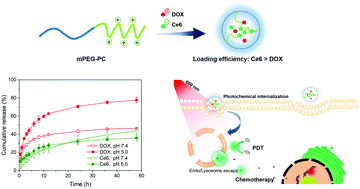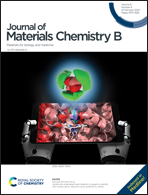Leveraging a polycationic polymer to direct tunable loading of an anticancer agent and photosensitizer with opposite charges for chemo–photodynamic therapy†
Abstract
Herein, we reported a primary amine containing polycationic polymer to load an oppositely charged anticancer drug (doxorubicin, DOX) and a photosensitizer (chlorin e6, Ce6) for combinational chemo–photodynamic therapy. The electrostatic interactions as well as other multiple interactions between the polymer and payloads endowed the drug-loaded nanoparticles with excellent stability. Moreover, the electrostatic attraction between the cationic polymer and anionic Ce6 dictated that Ce6 had higher loading efficiency than DOX. DOX showed pH-responsive drug release owing to the increased solubility of protonated DOX and reduced interaction with the partially protonated polymer under acidic conditions. In contrast, Ce6 showed pH-insensitive release because of the smaller change in solubility and the intense interactions between Ce6 and the polymer. Synergistic chemo/photodynamic therapy of 4T1 cancer cells was achieved by light-triggered reactive oxygen species (ROS)-mediated enhanced cellular uptake and effective endo/lysosomal escape of drug-loaded nanoparticles. Our study demonstrated that the polycationic polymer could act as a robust carrier for differential loading and release of oppositely charged cargos for combinational therapy.



 Please wait while we load your content...
Please wait while we load your content...